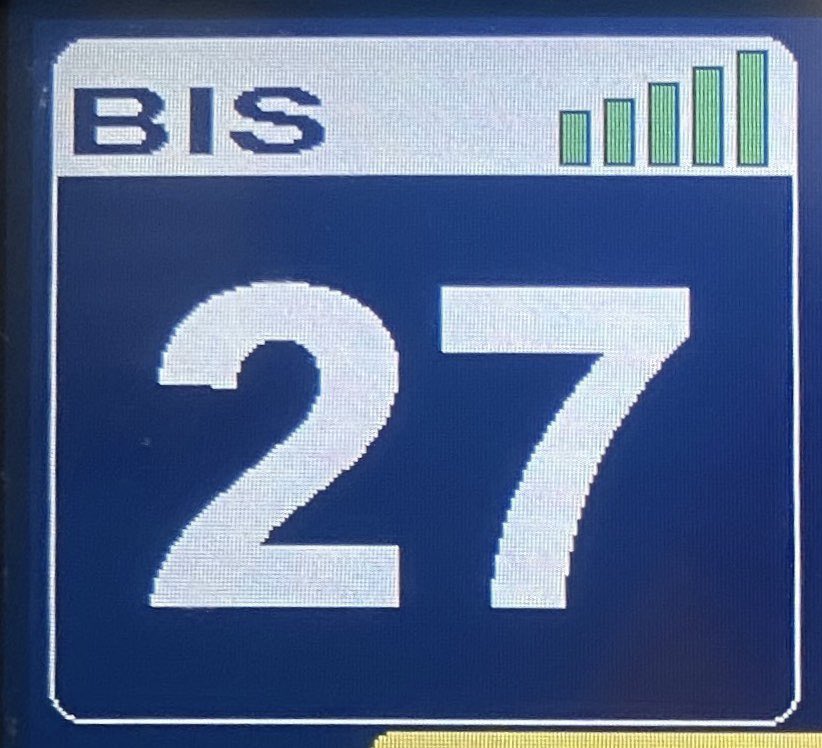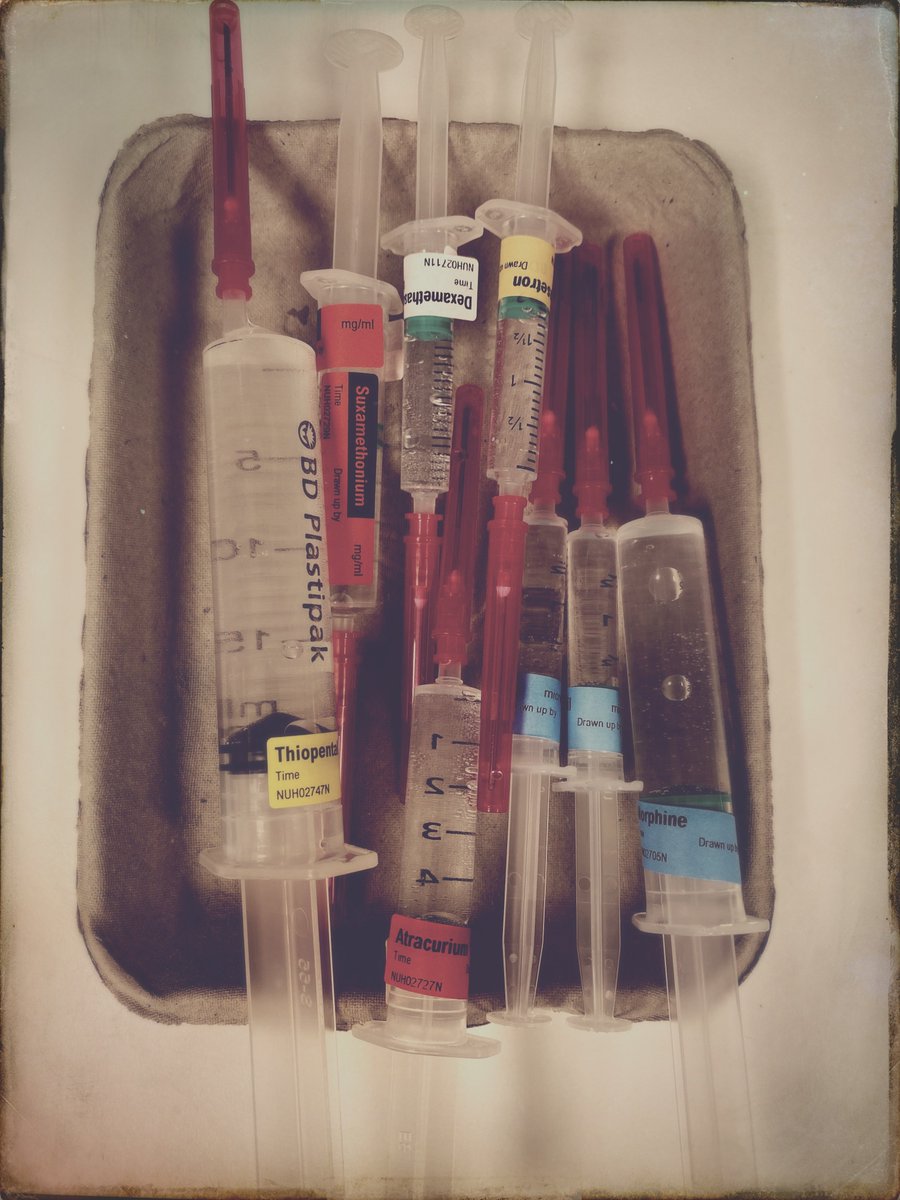BIS - what would you do?
50M, TIVA TCI + Spinal.
Propofol (Marsh) Cp 2.6
Remi (Minto) Ce 2
Filters OFF.
[Tweetorial to follow… :) ]
50M, TIVA TCI + Spinal.
Propofol (Marsh) Cp 2.6
Remi (Minto) Ce 2
Filters OFF.
[Tweetorial to follow… :) ]

Too much? Too little?
The BIS index is pretty low…?
The BIS index is pretty low…?
I can almost hear the audience shouting “LOWER! LOWER!” on Bruce Forsyth’s Play your Cards Right!
(Could be an idea for a new game show…🤔
(Could be an idea for a new game show…🤔

Looking at the EEG, some lovely large delta oscillations (red) and good alpha power (green). Notice the larger amplitude alpha at the peak of the delta - 👌perfecto! 

Turning filters being OFF is the only way you’ll see these big delta oscillations. The EEG looks really flat with the filters on.
It’s a 2Hz high pass filter (and I think a notch filter at 47-50Hz?).
If you can turn them off, without electrical artifacts then do!
It’s a 2Hz high pass filter (and I think a notch filter at 47-50Hz?).
If you can turn them off, without electrical artifacts then do!

The other really important feature is that SR is 0.
On the BIS, the Suppression Ratio is the % of every 63 seconds where the EEG is pretty flat (+/- 0.5uV)
Outside of very specific circumstances, we should aim to keep SR at 0.
Red - highlights an algorithm transition point.
On the BIS, the Suppression Ratio is the % of every 63 seconds where the EEG is pretty flat (+/- 0.5uV)
Outside of very specific circumstances, we should aim to keep SR at 0.
Red - highlights an algorithm transition point.

So this is an appropriate EEG for a youngish brain under propofol maintained anaesthesia, fairly early in the case.
Fast forward a bit…
Propofol Cp 2.2
Remi 2
Notice the delta oscillations aren’t quite as mountainous - a bit less Tour de France?
Still a lovely alpha / delta pattern, but now we’re at 44!
(Goodness knows how I managed 1 second of “suppression” 😂)
Let’s think about why…
Propofol Cp 2.2
Remi 2
Notice the delta oscillations aren’t quite as mountainous - a bit less Tour de France?
Still a lovely alpha / delta pattern, but now we’re at 44!
(Goodness knows how I managed 1 second of “suppression” 😂)
Let’s think about why…

During induction we create large, slow delta oscillations (from brain stem arousal centres?) this patten transitions to a alpha/delta pattern during maintenance, these delta oscillations are from disruption of local cortico-cortical communication, and have a lower amplitude.
The BIS has four algorithms to choose from, to generate different ranges of numbers. They are “weighted” to blend seamlessly together (with experience you’ll note where the algorithm has failed to transition!)
This example is where low EMG prevented transition to BetaRatio.
This example is where low EMG prevented transition to BetaRatio.

The algorithms are:
1) BetaRatio - ratio of high (>20Hz) to low (<20Hz) beta, alters during sedation.
2) SyncFastSlow - Bispectral bit. Phase/amplitude relationships.
3) QUAZI - deals with low amplitude, undulating baseline.
4) Suppression Ratio - linear decrease in BIS as ⬆️SR
1) BetaRatio - ratio of high (>20Hz) to low (<20Hz) beta, alters during sedation.
2) SyncFastSlow - Bispectral bit. Phase/amplitude relationships.
3) QUAZI - deals with low amplitude, undulating baseline.
4) Suppression Ratio - linear decrease in BIS as ⬆️SR
How does the box know which algorithm to weight towards?
This fantastic ‘Big Data” study gives us insight:
dx.doi.org/10.1038%2Fs415…
Using a huge data set, and machine learning the team give us insight into a model of these decisions.
This fantastic ‘Big Data” study gives us insight:
dx.doi.org/10.1038%2Fs415…
Using a huge data set, and machine learning the team give us insight into a model of these decisions.
This decision tree is important; and explains odd values, and even Messner and Schuller’s daring awake NMB studies!
First point - you need a LOT of suppression to get LOW values. Almost 50%. I moan about this a lot. Sorrynotsorry.
Tighter coupling to suppression would be better
First point - you need a LOT of suppression to get LOW values. Almost 50%. I moan about this a lot. Sorrynotsorry.
Tighter coupling to suppression would be better

If suppression is not catastrophically high, EMG and SEF95 are evaluated next.
EMG falls at induction as propofol reduces the recticular activating system output.
Schuller demonstrated that if you paralyse awake people BIS falls due to this EMG based trigger! 🤔
EMG falls at induction as propofol reduces the recticular activating system output.
Schuller demonstrated that if you paralyse awake people BIS falls due to this EMG based trigger! 🤔

SEF95 [Spectral Edge Frequency 95%]
-frequency below which 95% of the EEG power lies.
MEF [Median Edge Frequency]
-frequency below which 50% of the EEG power lies.
This is generally well under 16Hz during anaesthesia - usually around 12.
See it on the updated BIS DSA screen.
-frequency below which 95% of the EEG power lies.
MEF [Median Edge Frequency]
-frequency below which 50% of the EEG power lies.
This is generally well under 16Hz during anaesthesia - usually around 12.
See it on the updated BIS DSA screen.

In the first image, our patient has an SEF of 9; theres a LOT of power in them there hills!
Working though the decision tree:
BSR is OK.
EMG and SEF are below first threshold.
SEF is below the second threshold.
This is the QUAZI algorithm range, producing values 21-41
Working though the decision tree:
BSR is OK.
EMG and SEF are below first threshold.
SEF is below the second threshold.
This is the QUAZI algorithm range, producing values 21-41

In the later image, with the foothills (lower delta power) SEF was 12. (Unusually I didn’t take a DSA pic, but trust me😘).
The weighting will be towards the SyncFastSlow algorithm producing values in the 41-61 range.
The weighting will be towards the SyncFastSlow algorithm producing values in the 41-61 range.

Why was the first pic “27” - I don’t know. QUAZI hasn’t been described in detail.
Was I happy? Yup!
Understanding a bit about the EEG, the neurophysiology, pharmacology and how the monitor works is pretty good fun. (Really!)
The context is more important than the numbers.
Was I happy? Yup!
Understanding a bit about the EEG, the neurophysiology, pharmacology and how the monitor works is pretty good fun. (Really!)
The context is more important than the numbers.

@threadreaderapp unroll
If I messed up the threading; there’s an unroll at the bottom!
To understand more about how the algorithms are weighted read this:
pubs.asahq.org/anesthesiology…
Rampil’s Primer remains an essential reference:
pubs.asahq.org/anesthesiology…
To understand more about how the algorithms are weighted read this:
pubs.asahq.org/anesthesiology…
Rampil’s Primer remains an essential reference:
pubs.asahq.org/anesthesiology…
• • •
Missing some Tweet in this thread? You can try to
force a refresh







